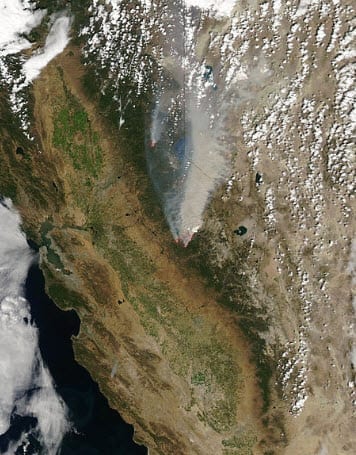According to catastrophe modeling firm AIR Worldwide, a massive wildfire that started just over a week ago is currently racing along the remote northwest corner of Yosemite National Park. Dry, warm conditions and winds gusts between 15 to 30 mph are fueling the blaze, which is currently at 7% containment. The fire has already consumed more than 225 square miles of Yosemite’s wilderness-known to be some of the most beautiful in the world-and is threatening two groves of California’s iconic sequoia trees.
According to the U.S. Forest Service, the fire is within a mile of Hetch Hetchy Reservoir-the source of 85 percent of San Francisco’s pure drinking water, as well as power for a number of key city buildings, including the airport. As a preparatory measure, the San Francisco Public Utilities Commission has shut down two hydroelectric stations fed by water from the reservoir and cut power to more than 12 miles of lines. However, as of Sunday evening, there had been no damage to the reservoir and the water was still clear and clean, despite fears that falling ash could contaminate the water.
“There are currently a dozen fires burning across California, but the Yosemite fire is the largest and most critical,” said Dr. Tomas Girnius, senior scientist at AIR Worldwide. “In an effort to control the blaze, twelve helicopters and a half-dozen fixed wing tankers are dropping water and retardant from the air and 2,800 firefighters are fighting the blaze on the ground. Their efforts have been hampered by strong winds, inaccessible terrain, and dry conditions. Flames that leap from treetop to treetop in what is known as a ‘crown fire’ are further complicating the fight, as firefighters have to spray up to contain the blazes.”
A voluntary evacuation was issued for Tuolumne City, Mi-Wuk Village, and smaller communities between them on Sunday, as officials feared that strong wind gusts could push the blaze closer to these locations. In addition, fire officials are using bulldozers to clear contingency lines about a mile ahead of the fire’s north side, and an evacuation center was set up in the city of Sonora, for those who chose to leave their homes.
In Yosemite National Park, the White Wolf Lodge and the White Wolf campground were evacuated Sunday afternoon due to poor air quality; however, the fire is not threatening these areas. The settling smoke has prompted many air districts in Northern California to issue health advisories.
Dr. Girnius observed, “The fire is currently within a mile of the Hetch Hetchy reservoir. If the reservoir  were to be contaminated, the San Francisco area would be able to get water from nearby reservoirs as the San Francisco Public Utilities Commission has emergency agreements in place. Also, San Francisco has bought enough supplemental power to ensure that the city will not lose power.”
were to be contaminated, the San Francisco area would be able to get water from nearby reservoirs as the San Francisco Public Utilities Commission has emergency agreements in place. Also, San Francisco has bought enough supplemental power to ensure that the city will not lose power.”
The fire has destroyed 23 structures and is threatening 4,500 more. It is unclear whether the destroyed structures were homes or rural outbuildings. Currently, the fire is threatening approximately three dozen giant sequoia trees in Yosemite. These trees, which are among the oldest in the world, can grow as tall as 311 feet and as wide as 100 feet. Given their massive size, they should not be damaged by the fire, but officials are still clearing brush and growth in a wide ring to prevent the fire from creeping closer.
Dr. Girnius concluded, “As of Saturday, the fire continued to spread to the north and east but at a slower rate than in the previous days. The fire’s progression toward the east could be further slowed due to more rock and less vegetation in its path. However, the opposite is true toward the north near Tuolumne and Twain Harte, which are 4 and 8 miles, respectively, away from the blaze. With dry, warm weather and strong southwest winds forecasted for the coming days, the situation in California should remain dynamic.”
AIR continues to monitor the situation in California and will provide more information as warranted by events.
